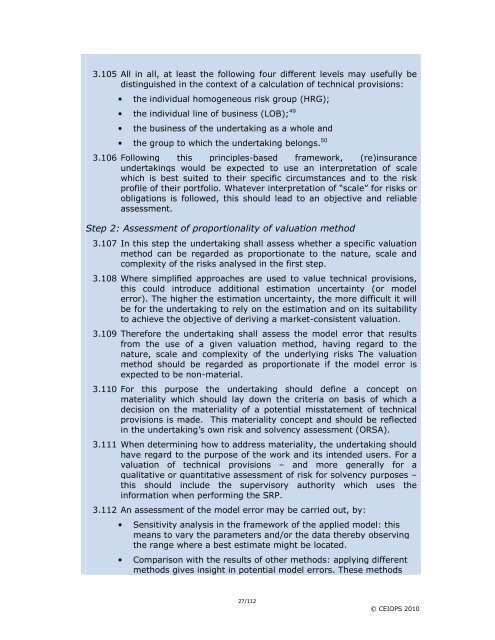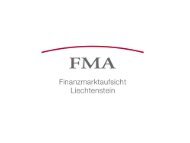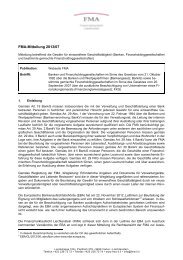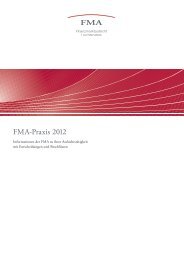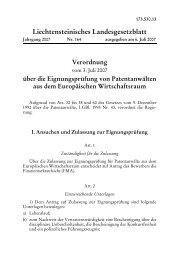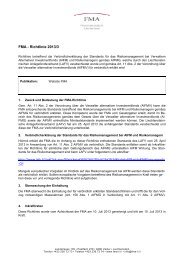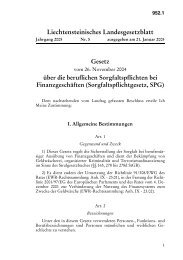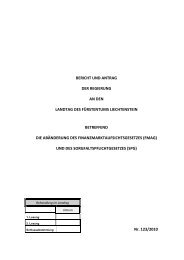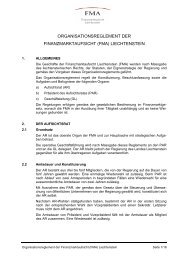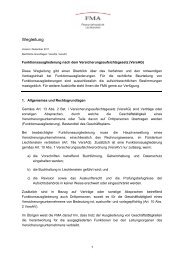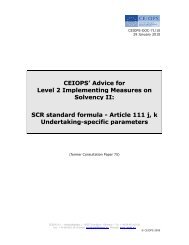CEIOPS' Advice for Level 2 Implementing ... - EIOPA - Europa
CEIOPS' Advice for Level 2 Implementing ... - EIOPA - Europa
CEIOPS' Advice for Level 2 Implementing ... - EIOPA - Europa
You also want an ePaper? Increase the reach of your titles
YUMPU automatically turns print PDFs into web optimized ePapers that Google loves.
3.105 All in all, at least the following four different levels may usefully be<br />
distinguished in the context of a calculation of technical provisions:<br />
• the individual homogeneous risk group (HRG);<br />
• the individual line of business (LOB); 49<br />
• the business of the undertaking as a whole and<br />
• the group to which the undertaking belongs. 50<br />
3.106 Following this principles-based framework, (re)insurance<br />
undertakings would be expected to use an interpretation of scale<br />
which is best suited to their specific circumstances and to the risk<br />
profile of their portfolio. Whatever interpretation of “scale” <strong>for</strong> risks or<br />
obligations is followed, this should lead to an objective and reliable<br />
assessment.<br />
Step 2: Assessment of proportionality of valuation method<br />
3.107 In this step the undertaking shall assess whether a specific valuation<br />
method can be regarded as proportionate to the nature, scale and<br />
complexity of the risks analysed in the first step.<br />
3.108 Where simplified approaches are used to value technical provisions,<br />
this could introduce additional estimation uncertainty (or model<br />
error). The higher the estimation uncertainty, the more difficult it will<br />
be <strong>for</strong> the undertaking to rely on the estimation and on its suitability<br />
to achieve the objective of deriving a market-consistent valuation.<br />
3.109 There<strong>for</strong>e the undertaking shall assess the model error that results<br />
from the use of a given valuation method, having regard to the<br />
nature, scale and complexity of the underlying risks The valuation<br />
method should be regarded as proportionate if the model error is<br />
expected to be non-material.<br />
3.110 For this purpose the undertaking should define a concept on<br />
materiality which should lay down the criteria on basis of which a<br />
decision on the materiality of a potential misstatement of technical<br />
provisions is made. This materiality concept and should be reflected<br />
in the undertaking’s own risk and solvency assessment (ORSA).<br />
3.111 When determining how to address materiality, the undertaking should<br />
have regard to the purpose of the work and its intended users. For a<br />
valuation of technical provisions – and more generally <strong>for</strong> a<br />
qualitative or quantitative assessment of risk <strong>for</strong> solvency purposes –<br />
this should include the supervisory authority which uses the<br />
in<strong>for</strong>mation when per<strong>for</strong>ming the SRP.<br />
3.112 An assessment of the model error may be carried out, by:<br />
• Sensitivity analysis in the framework of the applied model: this<br />
means to vary the parameters and/or the data thereby observing<br />
the range where a best estimate might be located.<br />
• Comparison with the results of other methods: applying different<br />
methods gives insight in potential model errors. These methods<br />
27/112<br />
© CEIOPS 2010


